The Trait Perspective on Personality
KEY THEME
Trait theories of personality focus on identifying, describing, and measuring individual differences.
KEY QUESTIONS
What are traits, and how do surface traits and source traits differ?
What are three influential trait theories, and how might heredity affect personality?
What are the key strengths and weaknesses of trait theories of personality?

Suppose we asked you to describe the personality of a close friend. How would you begin? Would you describe her personality in terms of her unconscious conflicts, the congruence of her self-
Trait theorists view the person as being a unique combination of personality characteristics or attributes, called traits. A trait is formally defined as a relatively stable, enduring predisposition to behave in a certain way. A trait theory of personality, then, is one that focuses on identifying, describing, and measuring individual differences in behavioral predispositions. Think back to our description of the twins, Kenneth and Julian, in the chapter Prologue. You can probably readily identify some of their personality traits. For example, Julian was described as impulsive, cocky, and adventurous, while Kenneth was serious, intense, and responsible. And people tend to describe others in terms of traits. Participants in a recent study in Germany were asked to describe people they knew (Leising & others, 2014). Across all participants, 624 adjectives were generated. Among these, the adjectives most frequently used were those that were more “traitlike,” such as extraverted and honest. It seems that it’s natural for us to think in this way.
People possess traits to different degrees. For example, a person might be extremely shy, somewhat shy, or not shy at all. Hence, a trait is typically described in terms of a range from one extreme to its opposite. Most people fall in the middle of the range (average shyness), while fewer people fall at opposite poles (extremely shy or extremely outgoing).
Surface Traits and Source Traits
Most of the terms that we use to describe people are surface traits—traits that lie on “the surface” and can be easily inferred from observable behaviors. Examples of surface traits include attributes like “happy,” “exuberant,” “spacey,” and “gloomy.” The list of potential surface traits is extremely long. Personality researcher Gordon Allport combed through an English-
Source traits are thought to be more fundamental than surface traits. As the most basic dimension of personality, a source trait can potentially give rise to a vast number of surface traits. Trait theorists believe that there are relatively few source traits. Thus, one goal of trait theorists has been to identify the most basic set of universal source traits that can be used to describe all individual differences (Pervin, 1994).
Two Representative Trait Theories
RAYMOND CATTELL AND HANS EYSENCK

How many source traits are there? Not surprisingly, trait theorists differ in their answers. Pioneer trait theorist Raymond Cattell reduced Allport’s list of 4,000 terms to about 171 characteristics by eliminating terms that seemed to be redundant or uncommon (see John, 1990). Cattell collected data on a large sample of people, who were rated on each of the 171 terms. He then used a statistical technique called factor analysis to identify the traits that were most closely related to one another. After further research, Cattell eventually reduced his list to 16 key personality factors, which are listed in Table 10.3.
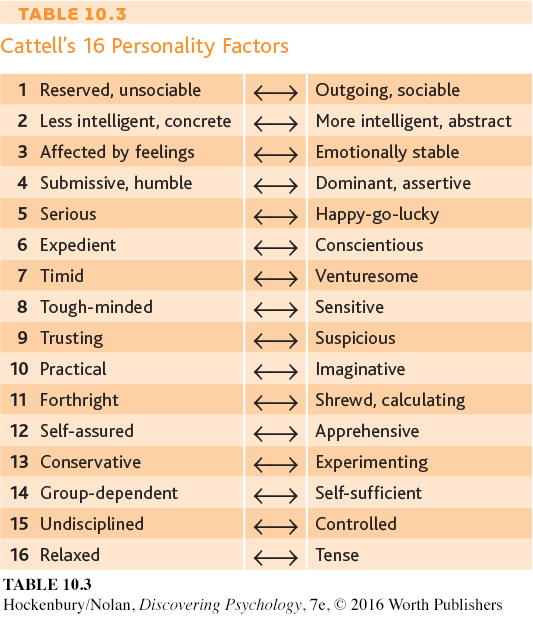
Cattell (1994) believed that these 16 personality factors represent the essential source traits of human personality. To measure these traits, Cattell developed what has become one of the most widely used personality tests, the Sixteen Personality Factor Questionnaire (abbreviated 16PF). We’ll discuss the 16PF in more detail later in the chapter.
An even simpler model of universal source traits was proposed by British psychologist Hans Eysenck (1916–
Eysenck’s second major dimension is neuroticism–
Eysenck believed that by combining these two dimensions, people can be classified into four basic types: introverted–
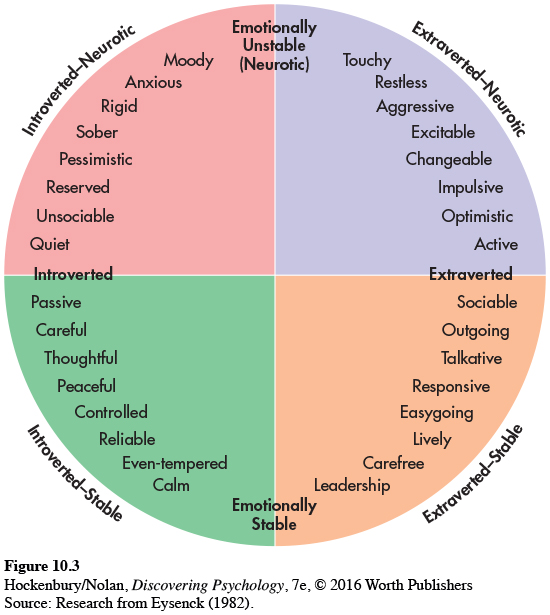
In later research, Eysenck identified a third personality dimension, called psychoticism (Eysenck, 1990; Eysenck & Eysenck, 1975). A person high on this trait is antisocial, cold, hostile, and unconcerned about others. A person who is low on psychoticism is warm and caring toward others. In the chapter Prologue, Julian might be described as above average on psychoticism, while Kenneth was extremely low on this trait.
Eysenck (1990) believed that individual differences in personality are due to biological differences among people. For example, Eysenck proposed that an introvert’s nervous system is more easily aroused than is an extravert’s nervous system. Assuming that people tend to seek out an optimal level of arousal (see Chapter 8), extraverts would seek stimulation from their environment more than introverts would. And, because introverts would be more uncomfortable than extraverts in a highly stimulating environment, introverts would be much less likely to seek out stimulation.
Do introverts and extraverts actually prefer different environments? In a clever study, John Campbell and Charles Hawley (1982) found that extraverted students tended to study in a relatively noisy, open area of a college library, where there were ample opportunities for socializing with other students. Introverted students preferred to study in a quiet section of the library, where individual carrels and small tables were separated by tall bookshelves. As Eysenck’s theory predicts, the introverts preferred study areas that minimized stimulation, while the extraverts preferred studying in an area that provided stimulation.
Eysenck’s proposal is backed by findings from neuroscience research. Among extraverts, PET scans showed increased activity in regions of the brain associated with the processing of sensory information, as compared with introverts (Johnson & others, 1999). The researchers speculated that the increased activity in certain areas of the brain in extraverts “may underlie these individuals’ high drive for sensory and emotional stimulation.”
Sixteen Are Too Many, Three Are Too Few
THE FIVE-
Many trait theorists felt that Cattell’s trait model was too complex and that his 16 personality factors could be reduced to a smaller, more basic set of traits. Yet Eysenck’s three-
Today, the consensus among many trait researchers is that the essential building blocks of personality can be described in terms of five basic personality dimensions, which are sometimes called “the Big Five” (Funder, 2001). According to the five-
What are the Big Five? Different trait researchers describe the five basic traits somewhat differently. However, the most commonly accepted five factors are neuroticism, extraversion, openness to experience, agreeableness, and conscientiousness. Table 10.4 summarizes the Big Five traits as defined by personality theorists Robert McCrae and Paul Costa, Jr. Note that Factor 1, neuroticism, and Factor 2, extraversion, are essentially the same as Eysenck’s first two personality dimensions.
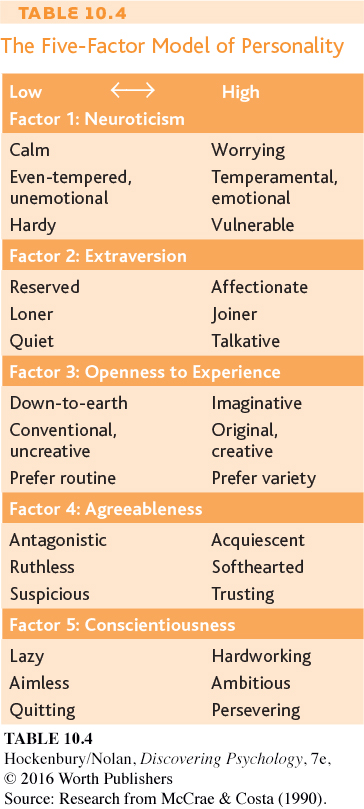
Use the acronym OCEAN to help you remember the five factors.
Does the five-
MYTH SCIENCE
Is it true that personality traits change quite a bit over the course of our lives?
How can we account for the apparent universality of the five-

Research has shown that traits are remarkably stable over time. A young adult who is very extraverted, emotionally stable, and relatively open to new experiences is likely to grow into an older adult who could be described in much the same way (Edmonds & others, 2013; McCrae & Costa, 2006; McCrae & others, 2000). However, this is not to say that personality traits don’t change at all. Longitudinal data suggest that some general trends are evident over the lifespan. These include a slight decline in neuroticism, an increase in agreeableness and conscientiousness, and stability in extraversion and openness to experience from early to late adulthood (Soto & others, 2011; Kandler, 2012). In other words, most people become more agreeable,conscientious, and emotionally stable as they mature psychologically (Caspi & others, 2005; Roberts & others, 2006).
Traits are also generally consistent across different situations. However, situational influences may affect the expression of personality traits. Situations in which your behavior is limited by social “rules” or expectations may limit the expression of your personality characteristics. For example, even the most extraverted person may be subdued at a funeral. In general, behavior is most likely to reflect personality traits in familiar, informal, or private situations with few social rules or expectations (A. H. Buss, 1989, 2001).
Given the consistency of traits over time and across situations, many psychologists think that traits may be associated with specific patterns of brain activity or structure (Canli, 2004, 2006; Sampaio & others, 2014). We discuss a recent attempt to investigate the relationship between brain structure and personality traits in the Focus on Neuroscience box on the next page, “The Neuroscience of Personality: Brain Structure and the Big Five.”
Keep in mind, however, that human behavior is the result of a complex interaction between traits and situations (Mischel, 2004; Mischel & Shoda, 2010; Sherman & others, 2015). People do respond, sometimes dramatically, to the demands of a particular situation. But the situations that people choose, and the characteristic way in which they respond to similar situations, are likely to be consistent with their individual personality dispositions (Mischel & Shoda, 1995; Mischel & others, 2002).
Personality Traits and Behavioral Genetics
JUST A CHIP OFF THE OLD BLOCK?
Do personality traits run in families? Are personality traits determined by genetics? Many trait theorists, such as Raymond Cattell and Hans Eysenck, believed that traits are at least partially genetic in origin. For example, Sandy and Don’s daughter, Laura, has always been outgoing and sociable, traits that she shares with both her parents. But is she outgoing because she inherited that trait? Or is she outgoing because outgoing behavior was modeled and reinforced? Is it even possible to sort out the relative influence that genetics and environmental experiences have on personality traits?
The field of behavioral genetics studies the effects of genes and heredity on behavior. Most behavioral genetics studies on humans involve measuring similarities and differences among members of a large group of people who are genetically related to different degrees. The basic research strategy is to compare the degree of difference among subjects to their degree of genetic relatedness. If a trait is genetically influenced, then the more closely two people are genetically related, the more you would expect them to be similar on that trait (see Chapter 7).

Such studies may involve comparisons between identical twins and fraternal twins or comparisons between identical twins reared apart and identical twins reared together. Adoption studies, in which adopted children are compared to their biological and adoptive relatives, are also used in behavioral genetics.
MYTH SCIENCE
Is it true that personality is not influenced by genetics, but is primarily shaped by your upbringing?
Evidence gathered from twin studies and adoption studies shows that certain personality traits are substantially influenced by genetics (Amin & others, 2011; de Moor & others, 2010; McCrae & others, 2010). The evidence for genetic influence is particularly strong for extraversion and neuroticism, two of the Big Five personality traits (Plomin & others, 1994, 2001; Weiss & others, 2008). Twin studies have also found that openness to experience, conscientiousness, and agreeableness are also influenced by genetics, although to a lesser extent (Bouchard, 2004; Harris & others, 2007).

FOCUS ON NEUROSCIENCE
The Neuroscience of Personality: Brain Structure and the Big Five
Many personality theorists, like Hans Eysenck, believed that personality traits are associated with characteristic biological differences among people (DeYoung & Gray, 2009). Some studies have confirmed this belief, identifying distinct patterns of brain activity associated with different personality traits (Canli, 2004, 2006). For example, brain-
Are personality traits also associated with brain structure? Psychologist Colin DeYoung and his colleagues had over 100 male and female participants undergo MRI scans and also take the NEO-
Extraversion was associated with larger brain tissue volume in the medial orbitofrontal cortex, a brain region that is associated with sensitivity to rewarding stimuli.
Agreeableness was associated with increased volume in the posterior cingulate cortex, a brain region associated with understanding the beliefs of others (Saxe & Powell, 2006). It was also associated with greater volume in the fusiform gyrus, an area of the cortex specialized for perceiving faces (see Chapters 3 and 7).
Conscientiousness was associated with a large region of the frontal cortex called the middle frontal gyrus, which is known to be involved in planning, working memory, and self-
regulation.
But not all personality traits had such clear correlations. Neuroticism was associated with a mixed pattern of brain structure differences. And DeYoung and his colleagues found no significant pattern of brain differences associated with openness to experience (Factor 5). They observed a slightly greater brain volume in one region that is associated with working memory and attention, but the difference was not statistically significant.
Are such studies merely phrenology with a modern face? These findings, while still preliminary, do suggest that there are biological influences on personality. It’s important to note, though, that the findings are correlational. It’s entirely possible that the brain differences are caused by different patterns of behavior rather than the other way around.
Further, unlike the phrenologists (see Chapter 2), today’s researchers are well aware that both brain differences and personality traits are shaped by the complex interaction of environmental, genetic, and biological influences. As DeYoung (2010) says, the ultimate goal is to use the methods of neuroscience to help generate a new theory of personality—
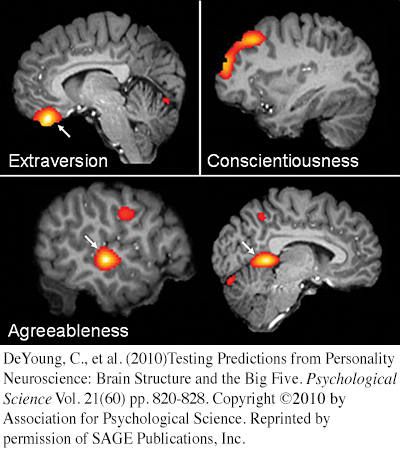
Genes confer dispositions, not destinies.
—Danielle Dick & Richard Rose (2002)
So is personality completely determined by genetics? Not at all. As behavioral geneticists Robert Plomin and Essi Colledge (2001) explain, “Individual differences in complex psychological traits are due at least as much to environmental influences as they are to genetic influences. Behavioral genetics research provides the best available evidence for the importance of the environment.” In other words, the influence of environmental factors on personality traits is at least equal to the influence of genetic factors (Rowe, 2003). For example, researchers have found that early experiences, such as having a parent with an anxiety disorder, affect whether a genetic vulnerability actually turns into a neurotic personality later in life (Barlow & others, 2014). Further underscoring this point is the fact that identical twins are most alike in early life. As the twins grow up, leave home, and encounter different experiences and environments, their personalities become more different (Bouchard, 2004; McCartney & others, 1990).
Evaluating the Trait Perspective on Personality

Although psychologists continue to disagree on how many basic traits exist, they do generally agree that people can be described and compared in terms of basic personality traits. But like the other personality theories, the trait approach has its weaknesses (Block, 1995).
One criticism is that trait theories don’t really explain human personality (Epstein, 2010; Pervin, 1994). Instead, they simply label general predispositions to behave in a certain way. Second, trait theorists don’t attempt to explain how or why individual differences develop (Boyle, 2008). After all, saying that trait differences are due partly to genetics and partly to environmental influences isn’t saying much.
A third criticism is that trait approaches generally fail to address other important personality issues, such as the basic motives that drive human personality, the role of unconscious mental processes, how beliefs about the self influence personality, or how psychological change and growth occur (Block, 2010; McAdams & Walden, 2010). Conspicuously absent are the grand conclusions about the essence of human nature that characterize the psychoanalytic and humanistic theories. So, although trait theories are useful in describing individual differences and predicting behavior, there are limitations to their usefulness.
As you’ve seen, each of the major perspectives on personality has contributed to our understanding of human personality. The four perspectives are summarized in Table 10.5.
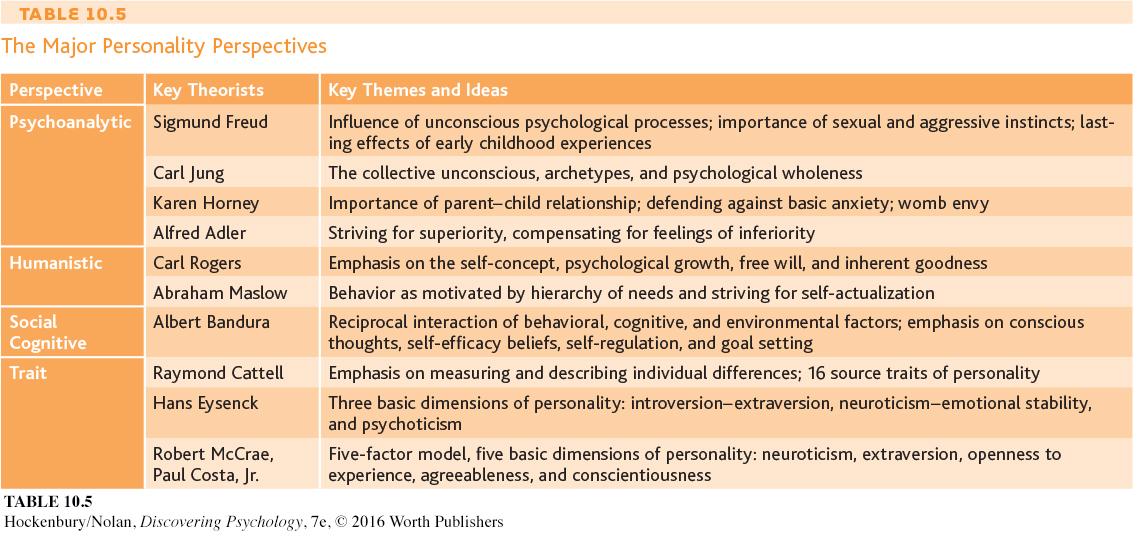
Our discussion of personality would not be complete without a description of how personality is formally evaluated and measured. In the next section, we’ll briefly survey the tests that are used in personality assessment.
Test your understanding of Different Perspectives on Personality with  .
.